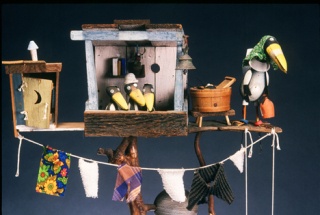By JANICE RANDALL
Vashon Allied Arts
The whimsical mixed media sculptures of Basil Milovsoroff (1906-1992) will be shown at the Blue Heron Gallery in January.
Opening at 6 p.m. Friday, Jan. 9, this rare exhibition will include a wide array of Milovsoroff’s prolific creative output.
Milovsoroff’s sculptures have been exhibited at many prestigious venues, including the International Puppetry Festival in Washington D.C., the University of Connecticut in Storrs and the Fleming Museum at the University of Vermont.
The works in the Blue Heron show, which are not for sale, are part of the private collection of Islander Peter Milovsoroff, who is Basil’s son.
“I plan to draw from the early years and his post-retirement years to show the scope of his work,” said Peter.
The sculptures in the show range in size from a few inches to six feet tall.
Born in Siberia, Russia, Basil immigrated to the United States at age 20 and landed at Oberlin College in Ohio, where he earned a master’s degree in political science. After seeing a puppet show, he enrolled in an art course where he created his first sculptures. Basil then decided to bring his sculptures to life through puppetry and created his first set of marionettes for the Russian folktale, “The Two Blind Beggars.”
Basil and his wife Georgia toured the United States from 1934 to 1944 as The Folktale Puppet Theater. Together they enacted Russian folklore and mythology through Basil’s fantastical mixed media assemblages for all-ages audiences from the East Coast to the Midwest.
In 1957, Milovsoroff started a new career as a professor of Russian at Dartmouth University until he retired in the early 1970s.
“When he re-entered the creative world, it was a great blossoming,” Peter said of his father. Influenced by African and Cubist art, elements from nature and a keen sense of humor, Basil created imaginative spirits and sprites, known as his Kikimora puppets. The term Kikimora refers to a ghostly character found in Slavic mythology.
Always a non-conformist, Milovsoroff used roots, springs, wire, marbles, leather, plastic, feathers and raffia, and his love of color can be seen throughout his decades of work.
To fully illustrate the inner workings of this innovative artist, his sketches and doodles will also be exhibited.
“He hated symmetry — nothing was ever straight in our house,” said Peter.


